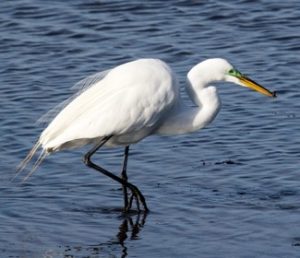
We all need fresh, clean water to live — fresh water is a resource shared by everyone. It is also a limited resource. In the Barnegat Bay watershed, almost all of our water is depletive, which means we don’t recharge it or recycle it. Either we consume water, or it goes down the drain to be treated by the county sewage authority and then pumped three miles out into the ocean. This method works well to remove the wastes from the watershed, but it puts a large strain on the water cycle!
More than 560,000 people now live in the Barnegat Bay watershed (more than double that in the summer), and we are still growing. With increased population comes increased water demand. As more people draw water from the groundwater for their own use, there is less groundwater available to “feed” streams and rivers and creeks, and ultimately less freshwater entering the bay. The bay needs an adequate fresh water flow to be healthy. People need an adequate supply of groundwater too.
How can we reduce demand for water outdoors?

Visit the Barnegat Bay Partnership’s Jersey-Friendly Yards website for great tips and resources about reducing water use in your home landscape.
Lawn care consumes huge amounts of water (the greatest percent of overall household water use). Reduce the impact of a lawn by using low maintenance grasses like tall fescues, which are drought resistant and require a lot less watering once established. Get tips for a low-maintenance lawn and find out why it makes sense to reduce lawn size on the Jersey-Friendly Yards website.
Consider replacing at least a section of your lawn with native species of trees, shrubs, and flowers in your garden – native plants are drought and pest resistant and also require a lot less watering once they are established. Go to our native plant webpage to download our native plant guide, Going Native: A Guide to Landscaping with Native Plants in the Barnegat Bay Watershed, and use the Jersey-Friendly Yards Plant Database to search for the right plants for the specific conditions in your yard.
Use porous materials for the hard surfaces in your yard whenever possible to let water pass through and get back into the ground. Options include gravel, pavers, crushed stone, and permeable asphalt or concrete.
Purchase or build your own rain barrel to harvest rainwater from the roof for lawn and garden irrigation. During a typical modest rainstorm of 1” of rain during a 24-hour period, 700 gallons of water will run off the average roof. Collecting this water in a rain barrel and using it to irrigate at home can really cut down on your water bill as well!
How can you increase the efficiency of your water use at home?
- In your home, use water-saving shower heads, sinks, and toilets.
- Fix dripping faucets and running toilets.
- Turn off the water while brushing your teeth or soaping your hands.
- Only run your dishwasher or washing machine when you have a full load.
Freshwater resources in the Barnegat Bay watershed
In the Barnegat Bay watershed, the primary sources of surface fresh water to the estuary are the Metedeconk River (a source of drinking water for residents of Brick Township, Point Pleasant and Point Pleasant Beach), Kettle Creek, Toms River, Cedar Creek, Forked River, Mill Creek, West Creek, and Tuckerton Creek.
Groundwater from the unconfined Kirkwood-Cohansey aquifer system is a major source of drinking water for the vast majority of residents of the Barnegat Bay watershed. This aquifer system is critical to the surface water quality in the watershed. It is regarded as the largest source of fresh water for the estuary because it provides the base flow for rivers and streams in the watershed.
Related Links
Jersey-Friendly Yards “Water Wisely”
WaterSense – a project of the US Environmental Protection Agency with a wealth of water conservation tips and product information.
The Water Page — list of links to general resources about water conservation and educational resources (lesson plans, diagrams, activities, and more).
How to Conserve Water in the Bathroom
USDA Forests to Faucets project
Rutgers Cooperative Extension of Ocean County — Sustainable Landscapes website.
Bayscaping resources available through the American Littoral Society website.
Native Plant Society of New Jersey

